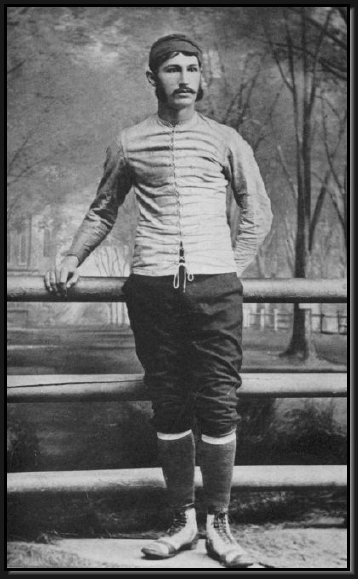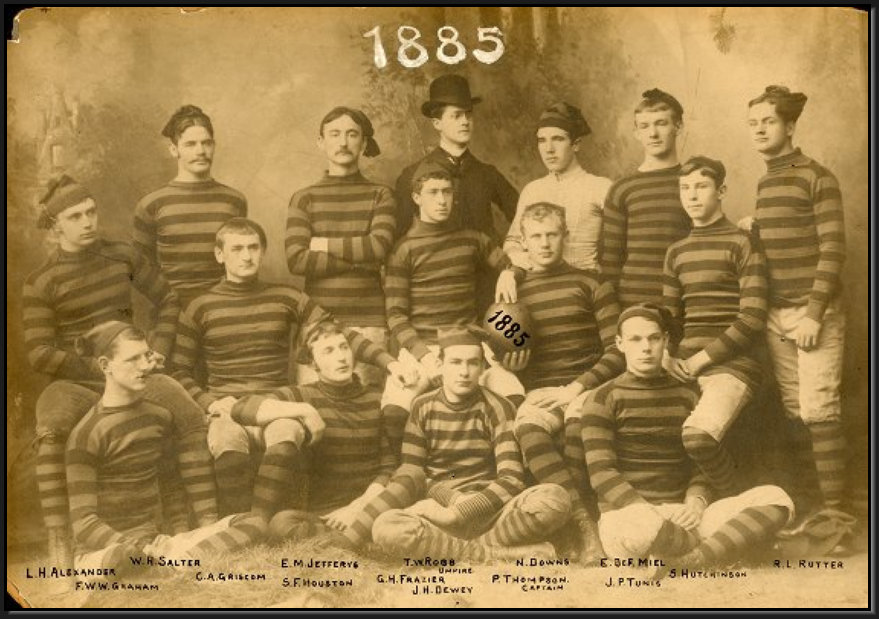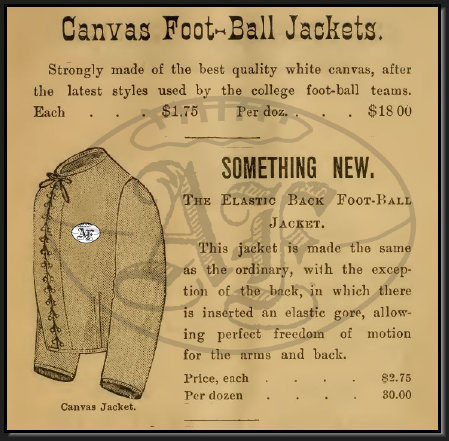The football uniform of 1876 consisted of "a common long-sleeved jersey, an ordinary pair of long trousers, heavy walking shoes, and a skull cap [Rockland]." As in rugby, players could only tackle above the waist, and it was common for a player to grab and pull his opponent's jersey to assist in the tackle. Tired of repairing and replacing torn jerseys, Ledru P. Smock, a Princeton freshman who desired to become university's three-quarter back, "concluded to find some remedy for the evil."
Smock designed a canvas jacket that fit snug to his body and laced up his back, requiring a friend's assistance to "suit up." Drawing jeers and laughs from the other students, Smock took the field.
Smock designed a canvas jacket that fit snug to his body and laced up his back, requiring a friend's assistance to "suit up." Drawing jeers and laughs from the other students, Smock took the field.
Remedying an Evil

Canvas, Lard, and Turpentine:
The Football Jacket
Chris Hornung
August 16, 2015
August 16, 2015

"....the moment he got the ball he dashed right in among his opponents. Tackling in those times was high, and, of course, sundry wild grabs were made for Smock's neck and shoulders. But he slipped through the grasp of everyone. Several players lost their finger nails in their efforts to stop the wearer of the improvised canvas jacket. As the game progressed it dawned upon the players that Smock had invented something worth thinking about, and it was only a few weeks aferward that home-made canvas jackets were worn by several players [Rockland]."
On April 28, 1877, Princeton faced played the Harvard Crimson in Cambridge, NY. Harvard protested when the Princeton eleven appeared wearing "Smocks." The canvas jackets gave Princeton an advantage, but the Tigers took it a step further. The players...
"...showed up buttered all over with lard, 'and in the game they greatly astonished the conservative New Haven by the way their runners slipped through the latters' fingers. Only by filling their hands with sand could tacklers retard the rushes."
Despite the protest and Princeton's unfair advantage, Harvard played the game and defeated Princeton 1-0. The following year, teams attempted to neutralize Princeton's lubricants by applying sticky resins and Venetian turpentine to their hands [Camp]. By 1878, nearly every major college football team had adopted some variation of Smock's jacket, which remained as standard equipment on the football field until around 1910. However, the Intercollegiate Football Association did put a stop to the use of applied substances in the early 1880's:
Walter Camp, Yale 1878 - wearing a "football jacket"
"Walter Camp - Project Gutenberg eText 18048".
"Walter Camp - Project Gutenberg eText 18048".

1885 University of Pennsylvania Team Photo, University of Pennsylvania University Archives

By the mid-1880's, sporting goods manufacturers began mass-producing long-sleeved jackets out of white canvas. The 1888 Spalding Official Football Guide advertisement for the "Canvas Foot-ball Jacket," hailed the latest style used by the college foot-ball teams, and a new "Elastic Back Foot-Ball Jacket." The new design provided players with a greater range of motion for $1.00 more than the $1.75 standard jacket price.
School Colors
Rule 23: - No sticky or greasy substance shall be used on the person of players.
Intercollegiate Football Rules for 1883
Foot-Ball Jacket Ad, Spalding Official Foot Ball Guide for 1888
1886 Harvard Football Team showing foot ball jackets with sleeves trimmed and removed
Removing the sleeves of the football jacket became so prevalent that in the early 1890's, Spalding and other football equipment manufacturers introduced the Foot Ball Jacket without sleeves; essentially a canvas vest. As the nineteenth century came to a close, jackets were also available in other materials, including white duck and moleskin. Spalding discontinued the long-sleeved football jacket in 1905, but continued to manufacture the sleeveless jacket until the mid-1910's.
Foot-Ball Jacket Ad, Spalding Official Foot Ball Guide for 1893
Smock's introduction of the canvas jacket not only impacted the evolution of football equipment, it changed the evolution of football itself. With the new uniforms, arm tackles and pulling the ball carrier to the ground quickly became obsolete. Proper tackling techniques and disciplined defensive alignments moved to the forefront of team strategy and defined elite teams.







Some players personalized their jackets by adding initials and team logos. Sleeves were frequently trimmed or removed entirely to further increase comfort and range of motion. The colors and patterns of the jerseys worn beneath jackets replaced multi-colored skull caps as the primary means of differentiating teams.
Princeton's black and orange striped sleeves earned the school's eleven the nickname "Tigers." Harvard's squad, whose classmates voted on their school color in May 6, 1875, donned a deep red beneath their vests and henceforth was referred to as the "Crimson."
Princeton's black and orange striped sleeves earned the school's eleven the nickname "Tigers." Harvard's squad, whose classmates voted on their school color in May 6, 1875, donned a deep red beneath their vests and henceforth was referred to as the "Crimson."
1892 Virginia Agricultural and Mechanical College (Virginia Tech) team photo - enlargement of William Jackson Barnes
Photo courtesy of Photograph Collection, Special Collections, University Libraries, Virginia Tech.
Photo courtesy of Photograph Collection, Special Collections, University Libraries, Virginia Tech.
Mass Production
The Sleeveless Jacket
Updated June 15, 2017
c. 1900 Uniform with Sleeveless Jacket
